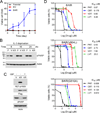Preclinical Modeling of KIF5B-RET Fusion Lung Adenocarcinoma
- PMID: 27496134
- PMCID: PMC5289739
- DOI: 10.1158/1535-7163.MCT-16-0258
Preclinical Modeling of KIF5B-RET Fusion Lung Adenocarcinoma
Abstract
RET fusions have been found in lung adenocarcinoma, of which KIF5B-RET is the most prevalent. We established inducible KIF5B-RET transgenic mice and KIF5B-RET-dependent cell lines for preclinical modeling of KIF5B-RET-associated lung adenocarcinoma. Doxycycline-induced CCSP-rtTA/tetO-KIF5B-RET transgenic mice developed invasive lung adenocarcinoma with desmoplastic reaction. Tumors regressed upon suppression of KIF5B-RET expression. By culturing KIF5B-RET-dependent BaF3 (B/KR) cells with increasing concentrations of cabozantinib or vandetanib, we identified cabozantinib-resistant RETV804L mutation and vandetanib-resistant-RETG810A mutation. Among cabozantinib, lenvatinib, ponatinib, and vandetanib, ponatinib was identified as the most potent inhibitor against KIF5B-RET and its drug-resistant mutants. Interestingly, the vandetanib-resistant KIF5B-RETG810A mutant displayed gain-of-sensitivity (GOS) to ponatinib and lenvatinib. Treatment of doxycycline-induced CCSP-rtTA/tetO-KIF5B-RET bitransgenic mice with ponatinib effectively induced tumor regression. These results indicate that KIF5B-RET-associated lung tumors are addicted to the fusion oncogene and ponatinib is the most effective inhibitor for targeting KIF5B-RET in lung adenocarcinoma. Moreover, this study finds a novel vandetanib-resistant RETG810A mutation and identifies lenvatinib and ponatinib as the secondary drugs to overcome this vandetanib resistance mechanism. Mol Cancer Ther; 15(10); 2521-9. ©2016 AACR.
©2016 American Association for Cancer Research.
Conflict of interest statement
of Potential Conflict of Interest The authors declare no conflict of interest.
Figures





References
-
- Nakamura H, Saji H. Worldwide trend of increasing primary adenocarcinoma of the lung. Surgery today. 2014;44:1004–1012. - PubMed
MeSH terms
Substances
Grants and funding
LinkOut - more resources
Full Text Sources
Other Literature Sources
Medical
Miscellaneous

